Pups In The Garden…Not The Soft, Cuddly Kind
I am talking about Agave babies, which are known as ‘pups’.
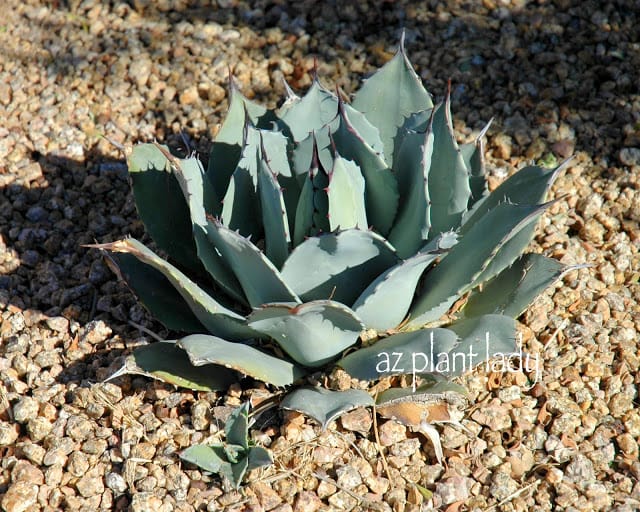
Parry’s Agave with small pup.
I knew that my Parry’s Agave, above, had a little pup growing. I have been keeping my eye on it, letting it grow a little bit more before I take it and place it somewhere to grow on it’s own.
Now, I don’t meant to rub it in to my northern neighbors, but it was a beautiful day to be out in the garden so while I was taking pictures, I soaked up all of the warmth from the sun that I could. It has been rather cold lately (for us desert dwellers anyway) and today was a beautiful 68 degrees.
*I promise I will be envying your weather come August….
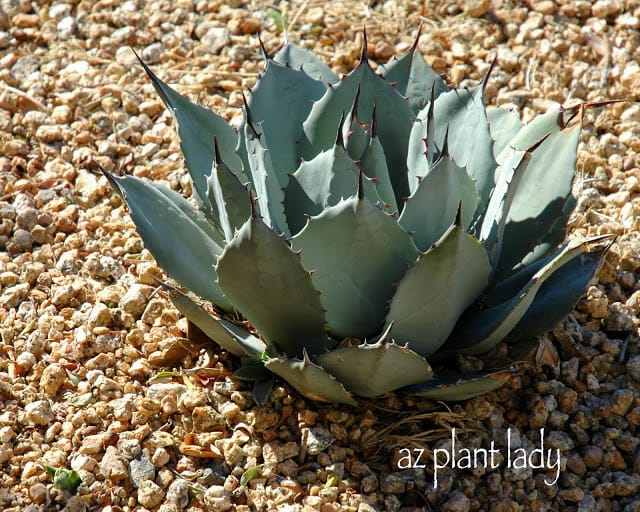
Little pup growing
Yesterday, on the other side of the same Agave, I had noticed the beginning of a little pup breaking through (in the far left corner of the photo). Well, as I was uploading the photo, I was in for another surprise. I noticed another pup growing right next to the Agave. I now have 3 Agave parryi pups to figure out where to place in my garden (what a wonderful problem to have). They are expensive Agave and do not produce a lot of pups as opposed to some other species of Agave.
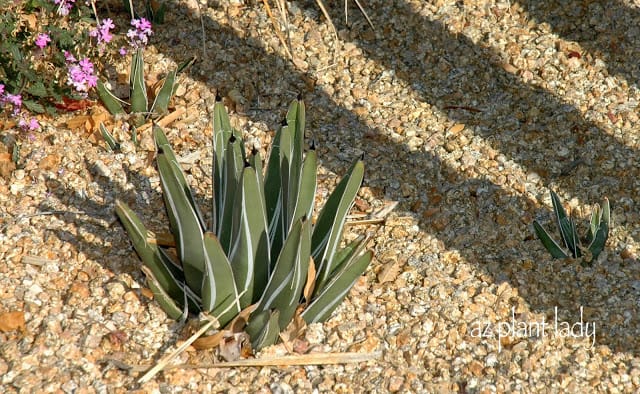
Victoria Agave (Agave victoria-reginae) parent plant and pups.
This is another of my favorite Agaves. How many pups can you see coming up from the larger parent plant? I count 3 pups, but there is actually another that is not in the photo. This Agave is also highly prized and expensive. Victoria Agave do not often produce pups, so I am very thankful that mine has been nice enough to give me 4.
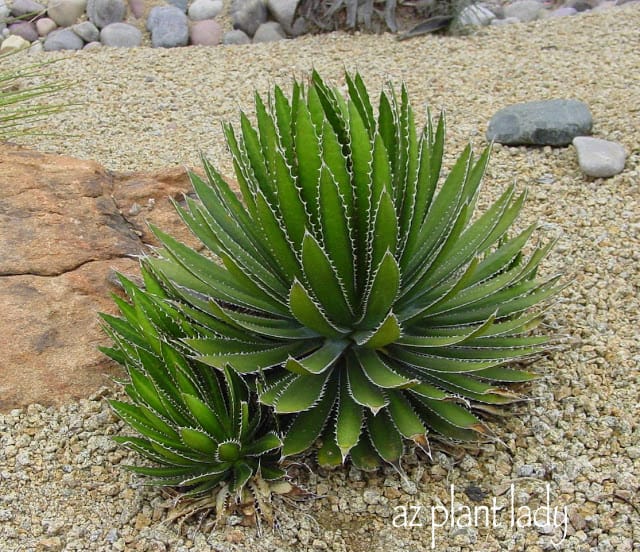
Agave lophantha with two pups.
Agave reproduce in two ways. One is by flowering at the end of their lifetime. The other way happens earlier in the Agave’s life span and that is by producing offsets called ‘pups’. The Agave sends out runners underground that produce the pups. The pups can be located right up next to the parent Agave or a few feet away.
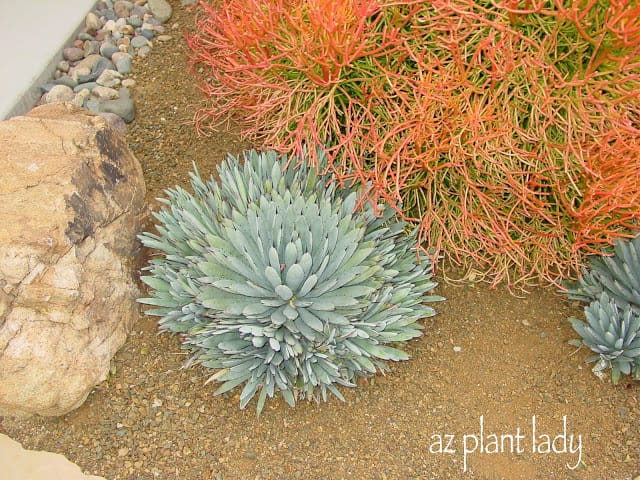
Agave macroacantha with many pups growing around it.
To remove, carefully expose the runner and cut with pruning shears or a sharp knife works well too. Before planting, the Agave pup needs to form a callus on the bottom, so place in a shady, dry spot for at least a week before planting. Agave pups can be planted out in the garden or placed in a container. Even better, you can give some to your friends.
Personally, I would do this in the spring or fall and avoid the hot summer months as this can add more stress as the Agave pup is struggling to grow roots to absorb water. But, that being said, Agave pups can be planted year-round.
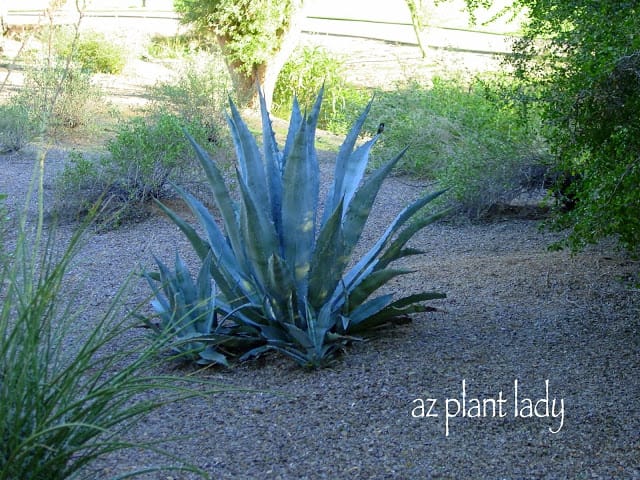
Agave americana with pups.
When most people think of Agave, they think of Agave americana (above). I do love the blue-gray leaves, but I stay away from using this particular Agave because they produce large amounts of pups. This leads to a lot of maintenance as the pups need to be removed frequently or they quickly become an overgrown mess. I have worked with many clients who have ended up pulling out their Agave americana for this very reason.
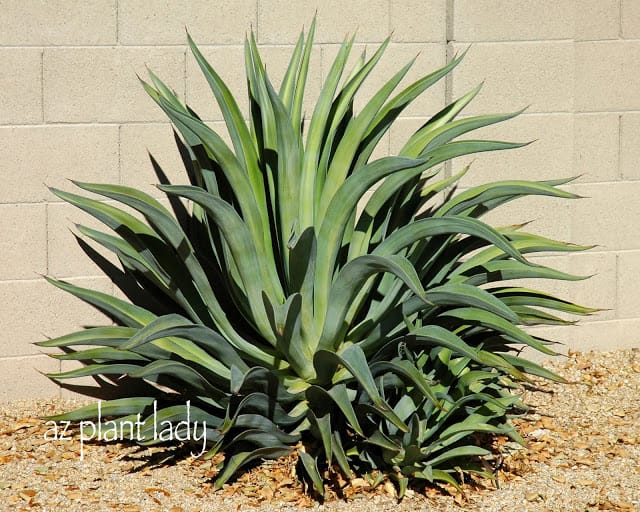
Agave desmettiana with two large pups. This Agave started life as a pup and was transplanted 4 years ago. It’s parent Agave flowered 3 years ago and died.
Okay, I admit, I am not the most organized gardener. I should have taken these large pups (on the right) and transplanted them last year. But, I promise I will as soon as it warms up. So, please do not wait to do this as long as I did. Agave pups do best when planted when they are small.
Agave desmettiana, (above), is a nice alternative to Agave americana as it grows large, but does not produce too many pups. It also has smoother edges in contrast to Agave americana.

Now, this photo does not have anything to do with this post, but my dog, Missy, loves to take advantage of any photo opportunities.

As does my son…
A Flood In The Garden….On Purpose

 Noelle Johnson, aka, 'AZ Plant Lady' is a author, horticulturist, and landscape consultant who helps people learn how to create, grow, and maintain beautiful desert gardens that thrive in a hot, dry climate. She does this through her consulting services, her online class Desert Gardening 101, and her monthly membership club, Through the Garden Gate. As she likes to tell desert-dwellers, "Gardening in the desert isn't hard, but it is different."
Noelle Johnson, aka, 'AZ Plant Lady' is a author, horticulturist, and landscape consultant who helps people learn how to create, grow, and maintain beautiful desert gardens that thrive in a hot, dry climate. She does this through her consulting services, her online class Desert Gardening 101, and her monthly membership club, Through the Garden Gate. As she likes to tell desert-dwellers, "Gardening in the desert isn't hard, but it is different."
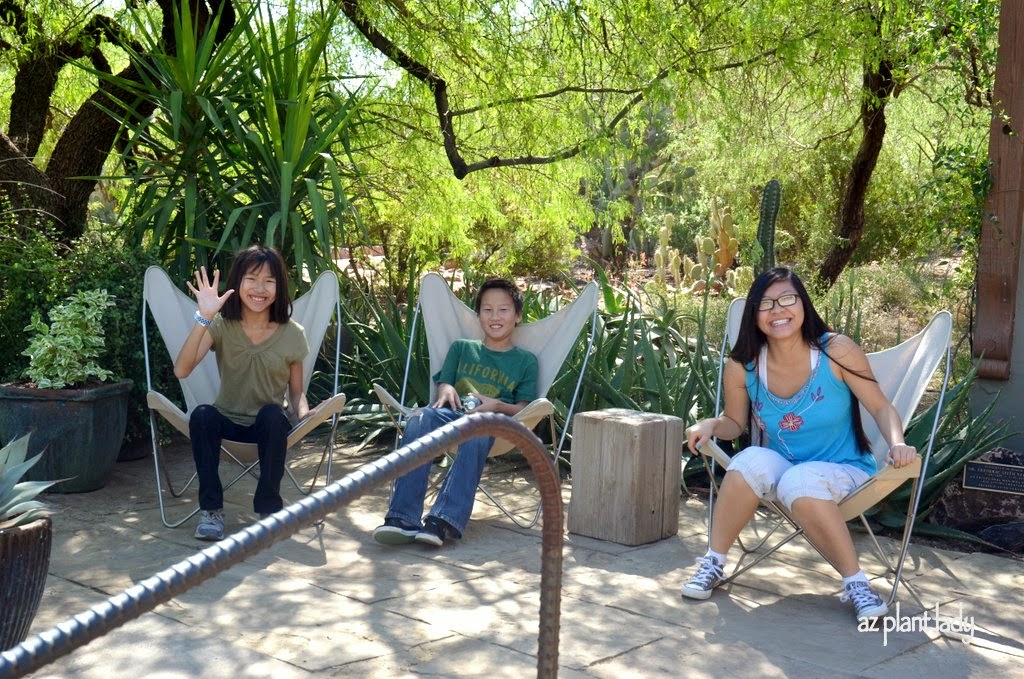

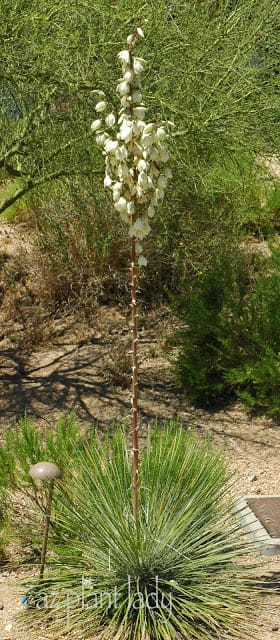

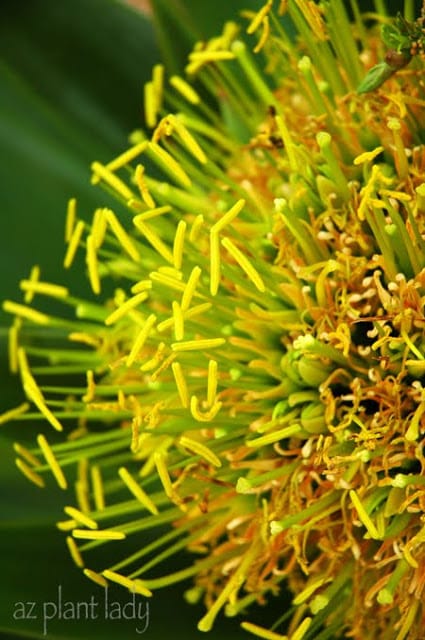
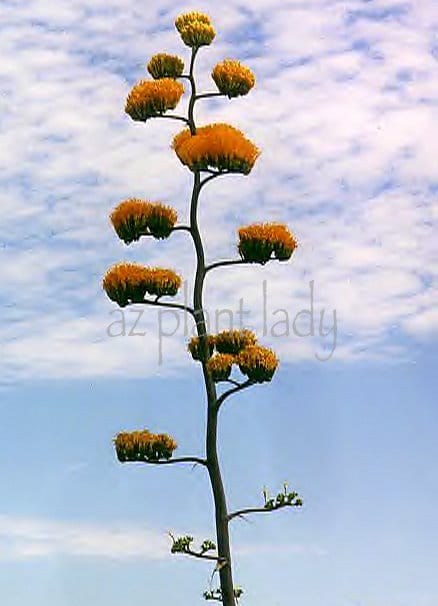






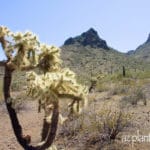
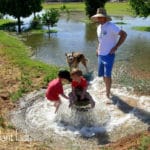
Hello Noelle and Happy New Year to you and your family!
I love the 'pups' and only wish we could grow agave here. I tried one a number of years ago, but it got frost bitten and never came back. Worth a try again though. Great looking son. I look forward to our year together. Diana
I'm learning all sorts of new things here! Your agave giving you more pups sounds like a great problem!
I was wondering while looking at your pictures, I bet you don't have many weeds there. Does the gravel mulch help? It always looks so tidy and weed free.
Oh, how wonderful! The pup envy is much stronger than the weather envy. Agave is moving up on my wishlist. Being a dessert plant, I wonder if it would do well as a houseplant where humidity loving plants are suffering. I'm thinking it's definitely worth getting one to trial. Thanks for the inspiration. 🙂
Beautiful and informative. My son, who lives nearby, tried them and and a variety of succulants but lost most to a freeze. He is a novice and just learning what works and what doesn't.
I'm pleased that he doesn't seem discouraged by his failures and keeps trying new plants.
Hi Noelle,
I enjoyed learning new things about agaves. You sure have some good looking ones! It is the Americana that my son has several pots of. He told me I can have one of them, but I keep forgetting to take it. I plan to keep it in the pot, because I don't know if they would grow in the ground here.
Happy New Year!
Noelle
Aww, they are so beautiful!! Love them all!
Evelyn
Great post! The pics of the pups and moms are adorable. Your son is adorable, the the dogs look great too. 🙂
Thanks for the intro to the agave plants. Our landscape guy in SC (he is putting in our sod and preparing garden beds—then I get to plant what I want.) has a big agave in his garden center that has some pups around it. I want one of his as I know for sure it is well suited to my area. Thiking I will put it at the mouth of the driveway (on the high side) and trying to figure out what to plant with it. Ideas??
I love puppies of any kind! Missy looks like she could be a cousin to my Sophie. As for the agaves, I fell in love with these the first time I visited Arizona. I brought back one tiny plant last year–specific variety forgotten for the moment–so I doubt I'll be seeing any pups for a long time, if ever. Thanks for reminding me that it's time to water mine–it's indoors, of course, and the person who sold it to me said to water it just once a month. I hope that sounds right.
Best Wishes for a Happy New Year!
Now I feel guilty. It's actually quite warm in the sun today, and my pups have been neglected through this cold spell. I should be out there removing them!
Happy New Year to you, Noelle, and thank you for all the desert gardening tips these past months.
Your post had me at the agaves but when I saw your golden I was really swept away. She's beautiful! Soft and cuddly for your son for sure.
The agaves look sensational but I don't think I could convince one to be happy in zone 3 or 4…. I'll just have to enjoy them in your yard through your posts.
Christine in Alaska
Hi Noelle, I believe your real-life pup may have been a little jealous of your taking photos of so many other "pups!" ha. What a fun bit of information you've given us. Yes – we trade uncomfortable seasons. 😉 Happy New Year!
How nice to gain so many free plants from Agave pups! Since arid desert gardening is so foreign to me, I enjoy reading about it on other blogs. Especially because my world is covered in snow, and I can only garden indoors!
Beautiful pictures-I love the form of agave Parri. I must get one someday-I grew one from seed but lost it in the last storm. How fortunate for you to get this and Victoriana to pup.
My Agave lophantha produces pups like crazy-and it’s in a large pot, I am sure if it had more room in the ground there would be even more. I did not know Agave macroacantha pups so readily-I do like its sharp symmetry-definitely one for me to consider in my next agave purchase. My 5 Agave desmettiana have never produced pups, but I feel that’s because they are in 3 gallon pots-will move some to the ground in the new garden in a few weeks.
Adorable “pups” in the last photo, too!
Lovely! This is my first visit (I found you from a comment at Patchwork Garden). I garden in the Texas Hill Country, which is not technically a desert but was the last two years, and I was tickled to have your advice on how to transplant pups.
Look forward to learning more from you as we gravitate toward dry-land plants.
Hello and thank you for your comments on my 'pups'.
Catherine, the gravel is found in most areas not covered with grass in the garden in our area. It does help with the weeds, but we still get them, usually after a rain. Applying pre-emergent, Round-up or just using a hula-hoe to remove them is what most people do. BTW, I took these photo the day after my husband pulled out our weeds 😉
Martha, agave make great potted plants. Maybe your son could try that and move them when the weather gets cold?
Hi Sue, that is the best idea. I have some agave in pots too, but I get to keep them outdoors all year.
Hello Janet, I love to plant low-growing groundcovers around my agave. I also try to pick a groundcover with contrasting colors to the agave. I would love to see a picture when you plant it 🙂
Hi Rose, Missy appreciates the compliment 🙂 Watering about once a month sounds about right, depending on the temperatures. Is it inside?
Noelle
Interesting info about the agaves, I didn't know they could grow so far away from the parent. I loved your hairy pups as well!
I really like your Parry's Agave, I have tried growing them several times here but they die each winter, not so much from the cold itself but from the late winter freeze/thaw that bursts the leaves. I have also tried the neomexicana (sp?), which are a little hardier. I envy your pups, and it was great reading some of your tips for growing them. Kathy
I have never seen such a variety of Agave Noelle! Beautiful and they must be very happy to give you so many pups. Great photos and post! Carol
So many varieties of Agave to learn about. Thanks for sharing your knowledge.
I am going to point my Dad to this website, he is living in AZ right now, snowbird.
Rosey
This was so informative and with such beautiful photos, thanks so much Noelle! I don't begrudge you warmth now, not at all. It is nice to see anyone enjoying the life giving warmth of the sun. Your photos are so sharp, the angle of the light is fabulous with the pointy daggers of the agaves. I wish we could grow some here. We have tried a couple of times, but our winters are so wet. I love seeing yours, that will do.
are the tips of the leaves very sharp? In work years ago we had a safety inspection and we were told to clip the ends of ours!
Great to see some of these things again that I just used to have in greenhouses when I was a Head Gardener, tho I recall americana and parryi being outside.
Fascinating and all so clearly explained.
Thanks
Robert
Happy New Year Noelle! What a great post … I never knew those little sprouts were called pups. Really enjoyed. Also enjoyed looking at that bright sunshine in your photos. Thank you!
Happy New Year Noelle!
Wish that you & your family have a wonderful promising year ahead.
Didn't know those babies are called pups. I have managed to collect few of these pups and had wrapped it with paper and awaiting to plant them. Must admit that its already more than a month but they seemed to be surviving.
Been very busy these few weeks.
Hi Noelle~~ Your son is adorable and the dogs are too. Agaves are such interesting plants. Do you correspond with Loree at Danger Garden? She is ga ga for Agave!!
MY Yuccas have propagated themselves this way too. 68 degrees sounds delightful.
Hi Noelle, I love the pups at the end of the post to go with the pup photos and info above. I am fascinated the way plants propogate. But I must say I avoid agaves because of their fierce spikes. Another interesting and informative post – thanks and happy new year to you. Cheers, catmint
Nice and neat garden… and I thought that little boy is a darling to her Mom… ~bangchik
Hi Noelle – Is there a good way to plant them without breaking off the foliage and also…sticking yourself? I had quite a time putting mine in a pot…ouch! -Amy
I'm so jealous of your agaves. I never grew them, until lately, when we moved to Central Texas. One isn't making it through this cold winter. I hope the others do.
Thanks for sharing the information about the pups. I'm hoping to have some to transplant some day.
Before I comment on the "pups" I have to say I'm jealous, jealous, jealous of 68 degrees!! That would feel so good about now!
Okay, back to the post. Your Agaves must be very happy to be producing so many pups! I don't have any in my garden and I should with my new water-wise plan in mind, right? I'll have to do more reading and remember which one you said not to plant! (if they'll grow here) Soak up the sunshine for us.
I love that the offshoots are called "pups". What happens to the ones that root close by when the parent plant dies? Do they make use of the source of nutrients or get caught in the rot? Your other three pups, canine and human, are gorgeous. Yan
Hello Again,
I am so happy so many of your have taken the time to comment on my 'pups'. I wanted to answer some of your questions:
Kathy, have you thought of planting your Agave parryi in a pot? That way you can move it in the winter to a protected area.
Rosey, thank you for telling your dad about my little blog 🙂
Frances, thank you so much for the photography compliment. That means so much to me coming from you 🙂
LeavenBloom, I do clip the top of sharp agave only if they are close to a pedestrian walkway, otherwise, I just leave them alone.
James, agave pups can survive for a little while before being planted. However, do be careful that they do not start to become 'wrinkled', which means that they do need to be planted right away.
Grace, I have corresponded a little with Loralee, but will follow up by reading her blog more often 🙂
Hi Catmint, there are many types of agave that are relatively thorn free including the Agave desmettiana in my post 🙂
Kathleen, please do try some agave! They are beautiful and low-maintenance and very drought-tolerant.
Yan, the pups do survive when the parent plant dies. I am not sure if they receive nutrients from the dying parent plant, but I would guess that they do.
Now much as I understand that every plant has its purpose and place in the landscape my childhood memories of encountering those vicious spines do not place the agaves on my list of desirables. But I enjoy reading your comments on the candidates for growing things in the desert. I can apply some of them to my mother's garden in California when I visit there. Both you and she seem to have success with roses that I can only dream about.
Hi, Noelle. I love this post, but if it includes agaves in any form, I am gonna love it.
I use newspaper to handle mine. Gloves are good, but the stickers can go right through. I use full sections of the newspaper to wrap around the plant and never get stuck. They are easy to plant like this too.
I have some you might not have, and I want one that you have. Wanna trade? LOL
My parents have the Agave americana in their backyard in Phoenix and it has indeed produced a startling number of pups. And spines. I like some of the other ones in your garden. I'll have to recommend some if my dad finally gets sick of pulling out little ones and gets rid of the big one.
Isn't ironic that we always wish for what we don't/can't have! I am lusting after your strong shapes in gravel whilst it has not stopped raining here for 60 hours. BUT I am planning a 'desert garden' on Sequoia for my sister's 50th in November, because she lives in Namibia. Drainage will have to be SHARP! Lovely lovely pics, Noelle! Jack
Noelle, what an informative post, and very considerate to put a comment in for us northerners. We got up to the upper 40's the other day, with sun, and I thought I was in heaven..
With Memorial Day practically around the bend, a large number of us are angling our trowels and gloves out of the sheds and heading into the terrace for some genuine (or not really genuine) gardening. In case you’re gardening with your pet this year, we have some awesome thoughts to help keep them safe and your garden in place..